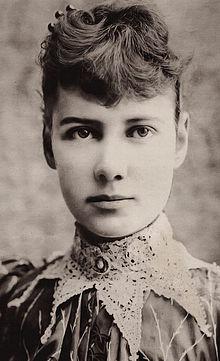
Intent on proving herself to him, she forced her way into his office - he had no interest in a female journalist and wouldn't see her - offering to take on this risky, dangerous assignment. Pulitzer, impressed by her passion, relented.
To get herself committed, Nellie had to of course act "insane." The way she went about it - claiming amnesia, alternately arguing and breaking into tears - probably wouldn't even get noticed today. But back in 1887 many indigent women - sane or not - were regularly tossed into mental institutions, as a convenient way of dealing with a social problem.
"Thus was Mrs. Louise Schanz consigned to the asylum without a chance of making herself understood. ... here was a woman taken without her consent from the free world to an asylum and there given no chance to prove her sanity. Confined most probably for life behind asylum bars, without even being told in her language the why and wherefore. Compare this with a criminal, who is given every chance to prove his innocence. Who would rather not be a murderer and take the chance for life than be declared insane, without hope of escape?
The process of being committed consisted of little more than a short meeting with a psychiatrist, who pretty much rubber-stamped every woman insane. After enduring hours in uncomfortable chairs, in a freezing cold waiting room, the ladies were shipped to the island where they were stripped, forcibly bathed in freezing cold water not changed from bath to bath - one woman with a serious medical condition later dying from long exposure to the cold - then given simple, thin gowns to wear:
"Suddenly I got, one after the other, three buckets of water over my head -- ice cold water, too -- into my eyes, my ears, my nose and my mouth. I think I experienced some of the sensations of a drowning person as they dragged me, gasping, shivering and quaking, from the tub."
Then it was back to a different room of uncomfortable chairs and freezing temperatures, with not so much as a shawl to cover their shivering bodies. This was where they spent the bulk of their days, whipped if they complained or got up to ease aching muscles.
And the food... Horrifying, with shades of David Copperfield:
"The bowls in which we had had our tea were now filled with soup, and on a plate was one cold potato and a chunk of beef, which in investigation, proved to be slightly spoiled. There were no knives or forks, and the patients looked fairly savage as they took the tough beef in their fingers and pulled in opposition with their teeth. Those toothless or with poor teeth could not eat it. One tablespoon was given for the soup, and a piece of bread was the final entree. (...) I saw many of the sick ones turn away in disgust.
Once in bed, conditions were no more restful. One blanket, wearing a thin gown, the situation was equally dire for the poor, freezing women. Then there's Nellie's excellent point:
"I could not sleep, so I lay in bed picturing to myself the horrors in case a fire should break out in the asylum. Every door is locked separately and the windows are heavily barred, so that escape is impossible. (...) Should the building burn, the jailers or nurses would never think of releasing their crazy patients. (...) All would be left to roast to death."
If you have the chance, I highly recommend giving this a read. The article is long but not overly so. The length is roughly equivalent to a novella. It's available as a free eBook via Amazon and I'm sure lots of libraries would have it. As for Miss Bly, the result of her report was a great reformation in the treatment of the mentally ill, including a more comprehensive system for declaring someone insane.
Among other distinctions she would go on to report having circumnavigated the world in 72 days, beating Jules Verne's fictional 80 day record. She gave up journalism in 1895, marrying Robert Seaman, a millionaire manufacturer of milk cans and boilers. She died, a childless widow, from pneumonia in 1922 and is buried in Woodlawn Cemetery, the Bronx.
What a fascinating, inspirational woman. Any kids out there looking for a research topic? Here you go. Nellie Bly was a brave woman, one of the world's first whistle blowers. I give her credit: the woman had some ovaries.

Thus comes to an end my 24-hours of reading. I certainly fit in all I could, considering I was working, visiting with relatives and such. I'm hoping to whomp on this year's performance next year. But one thing I'll say, this was a lot of fun.
